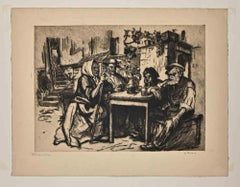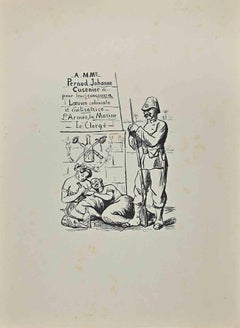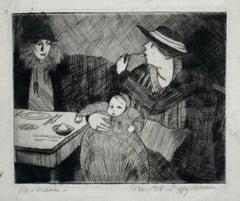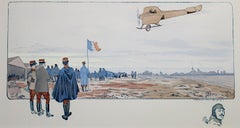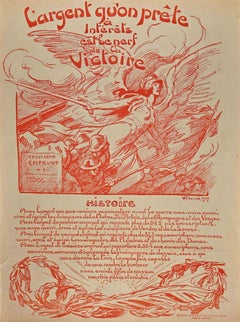1910s Figurative Prints
to
64
390
65
82
13
18
Overall Width
to
Overall Height
to
191
63
24
12
7
1
1
1
1
101
34
22
18
17
3,533
7,600
25,053
6,445
295
599
1,410
1,230
1,260
2,238
3,198
5,156
2,817
1,291
3,031
371
194
2
521
258
239
205
162
123
120
66
64
62
46
42
37
26
22
21
18
17
14
14
198
177
129
114
74
39
192
259
240
Period: 1910s
Drinkers - Etching By Pierre Georges Jeanniot - 1914
Located in Roma, IT
Drinkers is an Etching realized by Georges Jeanniot in 1914.
Signed on the lower, titled.
Good condition.
Category
Modern 1910s Figurative Prints
Materials
Etching
Colonial French Army - Lithograph - 1910s
Located in Roma, IT
Colonial French Army is a lithograph print on ivory-colored paper, realized in the 1910s by a French artist.
Good conditios with slight foxing.
The criti...
Category
Modern 1910s Figurative Prints
Materials
Lithograph
ICE CREAM
By Peggy Bacon
Located in Portland, ME
Bacon, Peggy (American, 1895-1987).
ICE CREAM. Flint 6.
Drypoint, 1918.
Edition size not known, but likely very small.
Titled "Ice Cream," dated "Nov. 19...
Category
1910s Figurative Prints
Materials
Drypoint
$2,500
L'ile Desert
Located in New York, NY
Jean-Emile Laboureur (1877-1943), L’ile Desert, etching, 1914, signed in pencil lower left and numbered lower right (33/35). Reference: Laboureur 135, only state, from the edition of...
Category
Cubist 1910s Figurative Prints
Materials
Etching
"French Air Show with Remarque of Head of Pilot, " Lithograph & Stencil by GAMY
Located in Milwaukee, WI
"French Air Show with Remarque of Head of Pilot" is an original lithograph and stencil print by Marguerite Montaut (GAMY). It depicts an early airplane flying above a crowd of specta...
Category
American Realist 1910s Figurative Prints
Materials
Lithograph, Stencil, Ink
L'Argent qu'on Prete - Lithograph by Victor Prouvé - 1917
Located in Roma, IT
L'Argent qu'on Prete is a Lithograph realized by Victor Prouvé in 1917.
Good condition on a brown paper.
Signed and dated under the drawing, stamped by Berger-Levrault (Paris-Nancy).
Victor Prouvé, born 13 August 1858 in Nancy, dead 15 February 1943 at Sétif (Algeria), was a French painter, sculptor and engraver of the Art Nouveau École de Nancy. He designed decors of glass works and furniture for Émile Gallé. He worked for Eugène Vallin...
Category
Modern 1910s Figurative Prints
Materials
Lithograph
Negres Americains a Saint-Nazaire
Located in New York, NY
Jean-Emile Laboureur (1877-1943), Negres Americains a Saint-Nazaire, 1917-1920, engraving on cream wove paper, signed in pencil lower left, titled lower left margin edge, and numbere...
Category
Cubist 1910s Figurative Prints
Materials
Engraving
BOSBOOM. 1917.
Located in New York, NY
ROLAND HOLST, R.N. (Richard) (1868-1938). “Eere Tentoonstelling Bosboom/ 1817 1917/ Pulchri-Studio ‘s Gravenhage/ 21 Apr[il] 31 Mei”. Color lithograph (pa...
Category
Symbolist 1910s Figurative Prints
Materials
Lithograph
Soldiers at the Front - Original Etching by Anselmo Bucci - 1917
Located in Roma, IT
Soldier at the Front is an original etching realized by Anselmo Bucci in 1917.
Limited edition of 200 copies.
The artwork represent a soldier at the front during War World 1st, 19...
Category
Modern 1910s Figurative Prints
Materials
Etching
Soldiers at the Front - Original Etching by Anselmo Bucci - 1917
Located in Roma, IT
Soldiers at the Front is an original etching realized by Anselmo Bucci in 1917.
Limited edition of 200 copies.
The artwork represent a soldier at the front during the War World 1st...
Category
Modern 1910s Figurative Prints
Materials
Etching
Military - Original Etching by Anselmo Bucci - 1910s
Located in Roma, IT
"Military" is a beautiful print in the etching technique, realized by Anselmo Bucci (1887-1955) in 1910s.
In good conditions.
The artwork represents the war scenery and an only pe...
Category
Modern 1910s Figurative Prints
Materials
Etching
Militant - Original Etching by Anselmo Bucci - 1917
Located in Roma, IT
"Military" 1917 is a beautiful print in etching technique, realized by Anselmo Bucci (1887-1955).
Hand signed. Numbered 89/100 of prints on the lower left. On the lower left corner,...
Category
Modern 1910s Figurative Prints
Materials
Etching
Militant - Original Etching by Anselmo Bucci - 1917
Located in Roma, IT
"Military" 1917 is a beautiful print in etching technique, realized by Anselmo Bucci (1887-1955).
Hand signed. Numbered 89/100 of prints on the lower left. On the lower left corner,...
Category
Modern 1910s Figurative Prints
Materials
Etching
Militant - Original Etching by Anselmo Bucci - 1917
Located in Roma, IT
"Military" 1917 is a beautiful print in etching technique, realized by Anselmo Bucci (1887-1955).
Hand signed. Numbered 61/100 of prints on the lower left. On the lower right corner...
Category
Modern 1910s Figurative Prints
Materials
Etching
Militant - Etching by Anselmo Bucci - 1917
Located in Roma, IT
"Military" 1917s is a beautiful print in etching technique, realized by Anselmo Bucci (1887-1955).
Hand signed. Numbered 81/100 of prints on the lower left. On the lower left corner...
Category
Modern 1910s Figurative Prints
Materials
Etching
Militant - Etching by Anselmo Bucci - 1917
Located in Roma, IT
"Military" 1917s is a beautiful print in etching technique, realized by Anselmo Bucci (1887-1955).
Hand signed. Numbered 61/100 of prints on the lower left. On the lower left corner...
Category
Modern 1910s Figurative Prints
Materials
Etching
Militant - Etching by Anselmo Bucci - 1917
Located in Roma, IT
"Military" 1917s is a beautiful print in etching technique, realized by Anselmo Bucci (1887-1955).
Hand signed. Numbered 61/100 of prints on the lower left. On the lower left corner...
Category
Modern 1910s Figurative Prints
Materials
Etching
Militant - Etching by Anselmo Bucci - 1917s
Located in Roma, IT
"Military" 1917s is a beautiful print in etching technique, realized by Anselmo Bucci (1887-1955).
Hand signed. Numbered 28/100 of prints on the lower left. On the lower left corner...
Category
Modern 1910s Figurative Prints
Materials
Etching
Military Life - Original Etching by Anselmo Bucci - 1917s
Located in Roma, IT
"Military" 1917s is a beautiful print in etching technique, realized by Anselmo Bucci (1887-1955).
Hand signed. Numbered 28/100 of prints on the lower left. On the lower left corner...
Category
Modern 1910s Figurative Prints
Materials
Etching
Military - Original Etching by Anselmo Bucci - 1917s
Located in Roma, IT
"Military" 1917s is a beautiful print in etching technique, realized by Anselmo Bucci (1887-1955).
Hand signed. Numbered 61/100 of prints on the lower left. On the lower left corner...
Category
Modern 1910s Figurative Prints
Materials
Etching
Military - Original Etching by Anselmo Bucci - 1917s
Located in Roma, IT
"Military" 1917s is a beautiful print in etching technique, realized by Anselmo Bucci (1887-1955).
Hand signed. Numbered 89/100 of prints on the lower left. On the lower left corner...
Category
Modern 1910s Figurative Prints
Materials
Etching
Militants - Original Etching by Anselmo Bucci - 1917
Located in Roma, IT
"Militants" 1917 is a beautiful print in etching technique, realized by Anselmo Bucci (1887-1955).
Hand signed. Numbered 89/100 of prints on the lower left. On the lower left corner...
Category
Modern 1910s Figurative Prints
Materials
Etching
Military - Original Etching by Anselmo Bucci - 1917
Located in Roma, IT
"Military" 1917s is a beautiful print in etching technique, realized by Anselmo Bucci (1887-1955).
Hand signed. Numbered 61/100 of prints on the lower left. On the lower left corner...
Category
Modern 1910s Figurative Prints
Materials
Etching
Military - Etching by Anselmo Bucci - 1917
Located in Roma, IT
"Military" 1917s is a beautiful print in etching technique, realized by Anselmo Bucci (1887-1955).
Hand signed. Numbered 61/100 of prints on the lower left. On the lower left corner...
Category
Modern 1910s Figurative Prints
Materials
Etching
Military - Etching by Anselmo Bucci - 1917
Located in Roma, IT
"Military" 1917s is a beautiful print in etching technique, realized by Anselmo Bucci (1887-1955).
Hand signed. Numbered 61/100 of prints on the lower left. On the lower left corner...
Category
Modern 1910s Figurative Prints
Materials
Etching
Military - Etching by Anselmo Bucci - 1917
Located in Roma, IT
"Military" 1917s is a beautiful print in etching technique, realized by Anselmo Bucci (1887-1955).
Hand signed. Numbered 89/100 of prints on the lower left. On the lower left corner...
Category
Modern 1910s Figurative Prints
Materials
Etching
Front Italien - Etching on Paper - 1918
Located in Roma, IT
Front Italien is a beautiful print in etching on paper, realized by Anselmo Bucci (1887-1955).
Good conditions.
Sheet dimension: 36 X 27.5
From th...
Category
1910s Figurative Prints
Materials
Etching
Le Front Italien - Etching on Paper by A. Bucci - 1918
Located in Roma, IT
Front Italien is a beautiful etching on paper, realized by Anselmo Bucci (1887-1955) in 1918.
Good conditions.
Sheet dimension: 27.5 x 35.5
From the collection: “Croquis du Front...
Category
1910s Figurative Prints
Materials
Etching
Marche - Original Etching by Anselmo Bucci - 1917
Located in Roma, IT
Image dimensions: 18.5 x 24.5 cm.
Hand signed. Edition of 100 prints on Hollande paper. From the collection: “Croquis du Front Italien”, published in Paris by D'Alignan editions. An...
Category
Futurist 1910s Figurative Prints
Materials
Drypoint, Etching
Otto et Fritz - Etching by Anselmo Bucci - 1917
Located in Roma, IT
Image dimensions: 9 x 11.5 cm.
Hand signed. Edition of 100 prints on Hollande paper. From the collection: “Croquis du Front Italien” , published in Paris by D'Alignan editions. Anse...
Category
Futurist 1910s Figurative Prints
Materials
Drypoint, Etching
Dans la Nuit - Etching by Anselmo Bucci - 1917
Located in Roma, IT
Image dimensions: 13.5 x 9.5 cm.
Hand signed. Edition of 100 prints on Hollande paper. From the collection: “Croquis du Front Italien” , published in Paris by D'Alignan editions. An...
Category
Futurist 1910s Figurative Prints
Materials
Drypoint, Etching
Avant l'Attaque - Etching by Anselmo Bucci - 1917
Located in Roma, IT
Image dimensions: 13.5 x 11.5 cm.
Hand signed. Edition of 100 prints on Hollande paper. From the collection: “Croquis du Front Italien”, published in Paris by D'Alignan editions. An...
Category
Futurist 1910s Figurative Prints
Materials
Drypoint, Etching
Chez la Fleuriste
Located in New York, NY
Jean-Emile Laboureur (1877-1943), Chez la Fleuriste, etching, 1919-1920, unsigned [with initials and date in the plate]. Reference: Laboureur 192, second state (of 2), from the editi...
Category
Cubist 1910s Figurative Prints
Materials
Etching
Die Loge im Gaite Montparnasse (Paris)
By Emil Orlik
Located in New York, NY
Emil Orlik (1870-1932), Die Loge im Gaite Montparnasse (Paris), drypoint, etching and soft ground, 1911, signed and numbered in pencil lower right, for the portfolio Zuschauer und Zu...
Category
1910s Figurative Prints
Materials
Drypoint, Etching
La Meuse - Etching by R.P. Grouillet - 1911
Located in Roma, IT
Original etching by Robert Pierre Grouiller after a painting by Johan Barthold Jongkind. Signed and dated on plate by Jongkind. Edition of 600 prints. Etching and aquatint print on v...
Category
Naturalistic 1910s Figurative Prints
Materials
Etching
Composition with Nudes - Hand Colored Lithograph by Max Lingner - 1911
By Max Lingner
Located in Roma, IT
Symbolic composition with nudes is a wonderful double-colored lithograph on paper realized by the German artist, Max Lingner (Leipzig, 1988- Berlin, 1969).
Monogram and date on pla...
Category
Symbolist 1910s Figurative Prints
Materials
Lithograph
Nude of a Man - Hand Colored Lithograph by Max Lingner
By Max Lingner
Located in Roma, IT
Nude of a man is a wonderful double-colored lithograph on paper realized by the German artist, Max Lingner (Leipzig, 1988- Berlin, 1969).
Signature and date on plate on lower right...
Category
Symbolist 1910s Figurative Prints
Materials
Lithograph
Tartessians
Located in New York, NY
Arthur B. Davies (1862-1928), Tartessians, soft ground etching with aquatint, 1919-20, signed in pencil lower right. Reference: Czestochowski 96, second state (of 2), total printing ...
Category
American Impressionist 1910s Figurative Prints
Materials
Etching, Aquatint
Figures in the Landscape - Etching by J. A. Flour - 1916
By Jules Adrian Flour
Located in Roma, IT
Figures in the Landscape is an original artwork realized by Jules Adrian Flour in 1916. Original etching on paper.
The artwork is glued on cardboard. Hand-signed in pencil by the ar...
Category
Post-Impressionist 1910s Figurative Prints
Materials
Etching
Resurrection (aka Flying Figures; Border of the Lake)
Located in New York, NY
Arthur B. Davies (1862-1928), Resurrection (aka Flying Figures; Border of the Lake), drypoint and aquatint on zinc, 1916, signed with the estate stamp lower right. Reference: Price 2...
Category
American Impressionist 1910s Figurative Prints
Materials
Drypoint, Aquatint
Le Marché aux Fleurs ou la Rencontre
Located in New York, NY
Jean-Emile Laboureur (1877-1943), Le Marché aux Fleurs ou la Rencontre, 1914, Engraving. Sylvain Laboureur 127, second state (of 2). Edition of 35. Signed, titled, and numbered 2/35 ...
Category
Cubist 1910s Figurative Prints
Materials
Engraving
Am Gänsehäufel in Wien
By Emil Orlik
Located in New York, NY
Emil Orlik (1870-1932), Am Gänsehäufel in Wien, 1911, soft-ground etching, signed and dated in pencil lower right. In very good condition, on firm laid paper with margins, 5 1/2 x 8...
Category
Expressionist 1910s Figurative Prints
Materials
Etching
La Cabaretiere obese (The Fat Tavern Keeper)
Located in New York, NY
1917. (Godefroy 172, II/II). Engraving on Rives. Signed with initial and dated on the plate, l.r "L 1917". Signed in pencil and numbered 28/45. Framed
Stein, The Cubist Print p. 14...
Category
Cubist 1910s Figurative Prints
Materials
Engraving
Kino Plasticon
By Faragó Géza
Located in New York, NY
Kino Plasticon. Ca 1920s. Budapest. Color lithograph
The Hungarian artist and illustrator Geza Farago worked in Budapest as a cartoonist, theatrical costume designer and poster ar...
Category
Art Deco 1910s Figurative Prints
Materials
Lithograph
Children in Mulberry Street
By Jerome Myers
Located in New York, NY
Jerome Myers (1867-1940), Children in Mulberry Street, c. 1910, soft ground etching and plate tone, signed in pencil lower right. In good condition (apart from weakening at platemark...
Category
American Realist 1910s Figurative Prints
Materials
Etching
Le Docteur Ballanzone
Located in New York, NY
Pochoir Colored Plate for Journal Des Dames et Des Modes. Engraved by H. Reidel on wove paper. 15 x 19.5". 1914
Pochoir is a process where the plate is first stenciled and then ha...
Category
Art Deco 1910s Figurative Prints
Materials
Engraving, Color
Up-Rising
Located in New York, NY
Arthur B. Davies, Up-Rising, soft ground etching and aquatint on a cream laid paper, 1919, signed in pencil lower right margin. Reference: Czestochowski 78, second state (of 3). In g...
Category
American Impressionist 1910s Figurative Prints
Materials
Etching, Aquatint
Untitled Woodcut
Located in Wilton, CT
Original hand-colored woodcut from a portfolio of Secessionist fashion illustrations. Signed in the lower right margin by the artist, Reni Schaschl (1895-1979), a talented member of...
Category
Vienna Secession 1910s Figurative Prints
Materials
Woodcut
$2,800 Sale Price
20% Off
La Poursuite by Orovida Pissarro - Animal etching
Located in London, GB
La Poursuite by Orovida Pissarro (1893-1968)
Etching with aquatint
17.2 x 12.5 cm (6 ³/₄ x 4 ⁷/₈ inches)
Signed and dated lower right Orovida 1917
Inscribed lower left Final State Trial proof no. 1
Artist biography
Orovida Camille Pissarro, Lucien and Esther Pissarro’s only child, was the first woman in the Pissarro family as well as the first of her generation to become an artist. Born in Epping, England in 1893, she lived and worked predominantly in London where she became a prominent member of several British arts clubs and societies.
She first learned to paint in the Impressionist style of her father, but after a brief period of formal study with Walter Sickert in 1913 she renounced formal art schooling. Throughout her career, Orovida always remained outside of any mainstream British art movements. Much to Lucien's disappointment she soon turned away from naturalistic painting and developed her own unusual style combining elements of Japanese, Chinese, Persian and Indian art. Her rejection of Impressionism, which for the Pissarro family had become a way of life, together with the simultaneous decision to drop her famous last name and simply use Orovida as a ‘nom de peintre’, reflected a deep desire for independence and distance from the weight of the family legacy.
Orovida's most distinctive and notable works were produced from the period of 1919 to 1939 using her own homemade egg tempera applied in thin, delicate washes to silk, linen or paper and sometimes embellished with brocade borders. These elegant and richly decorative works generally depict Eastern, Asian and African subjects, such as Mongolian horse...
Category
1910s Figurative Prints
Materials
Etching, Aquatint
$993 Sale Price
20% Off
After Tea by Ludovic-Rodo Pissarro - Wood engraving
Located in London, GB
After Tea by Ludovic-Rodo Pissarro (1878-1952)
Wood engraving
12 x 13.2 cm (4 ³/₄ x 5 ¹/₄ inches)
Initialled and titled in the plate
Executed circa 1917
Artist biography
Ludovic-Rod...
Category
Post-Impressionist 1910s Figurative Prints
Materials
Woodcut
Portrait by Orovida Pissarro - etching
Located in London, GB
Portrait by Orovida Pissarro (1893-1968)
Etching
25 x 16.5 cm (9 ⁷/₈ x 6 ¹/₂ inches)
Signed and dated lower right, Orovida 1919
Inscribed lower left, Trial proof no. 20 and titled lo...
Category
1910s Figurative Prints
Materials
Etching, Paper
Bank Holiday by Ludovic-Rodo Pissarro - Wood engraving
Located in London, GB
SOLD UNFRAMED
Holiday by Ludovic-Rodo Pissarro (1878-1952)
Wood engraving
15.2 x 11.5 cm (6 x 4 ½ inches)
Initialed and titled in the plate
Signed lower right, Ludovic Rodo and nu...
Category
1910s Figurative Prints
Materials
Engraving, Woodcut
Jeune Polonaise
Located in London, GB
Henri Matisse
Jeune Polonaise
1917/18
Etching on Chine appliqué on wove paper, Edition of 15
Paper size: 38 x 28.5 cms (15 x 11 1/4 ins)
Plate size: 18 x 12.7 cms (7 x 5 ins)
HM16662
Category
1910s Figurative Prints
Materials
Etching
Reception by Ludovic-Rodo Pissarro - Woodcut
Located in London, GB
Reception by Ludovic-Rodo Pissarro (1878-1952)
Wood engraving
14 x 11.5 cm (5 ¹/₂ x 4 ¹/₂ inches)
Initialed and titled in the plate
Signed lower right, L...
Category
1910s Figurative Prints
Materials
Woodcut
"Mlle Landsberg" (grade planche, pl. 16)
Located in Missouri, MO
"Mlle Landsberg" (grade planche, pl. 16), 1914
Henri Matisse (French, 1869-1954)
Signed and Numbered Lower Right
Edition 12/15
Image size: 7 7/8 x 4 5/16 inches
Sheet size: 17 11/16 x 12 1/2 inches
With frame: 19 1/2 x 14 1/2 inches
Henri Matisse came from a family who were of Flemish origin and lived near the Belgian border. At eight o'clock on the evening of December 31, 1869, he was born in his grandparents' home in the town of Le Cateau in the cheerless far north of France. His father was a self-made seed merchant who was a mixture of determination and tightly coiled tension.
Henri had no clear idea of what he wanted to do with his life. He was a twenty-year-old law clerk convalescing from appendicitis when he first began to paint, using a box of colors given to him by his mother. Little more than a year later, in 1890, he had abandoned law and was studying art in Paris. The classes consisted of drawing from plaster casts and nude models and of copying paintings in the Louvre. He soon rebelled against the school's conservative atmosphere; he replaced the dark tones of his earliest works with brighter colors that reflected his awareness of Impressionism. Matisse was also a violinist; he took an odd pride in the notion that if his painting eye failed, he could support his family by fiddling on the streets of Paris.
Henri found a girlfriend while studying art, and he fathered a daughter, Marguerite, by her in 1894. In 1898 he married another woman, Amelie Parayre. She adopted the beloved Marguerite; they eventually had two sons, Jean, a sculptor and Pierre who became an eminent art dealer. Relations between Matisse and his wife were often strained. He often dallied with other women, and they finally separated in 1939 over a model who had been hired as a companion for Mme. Matisse. She was Madame Lydia, and after Mme. Matisse left, she remained with Matisse until he died.
Matisse spent the summer of 1905 working with Andre Derain in the small Mediterranean seaport of Collioure. They began using bright and dissonant colors. When they and their colleagues exhibited together, they caused a sensation. The critics and the public considered their paintings to be so crude and so roughly crafted that the group became known as Les Fauves (the wild beasts).
By 1907, Matisse moved on from the concerns of Fauvism and turned his attention to studies of the human figure. He had begun to sculpt a few years earlier. In 1910, when he saw an exhibition of Islamic art, he was fascinated with the multiple patterned areas and adapted the decorative universe of the miniatures to his interiors. As a continuation of his interest in the "exotic", Matisse made extended trips to Morocco in 1912 and 1913.
At the end of 1917, Matisse moved to Nice; he would spend part of each year there for the remainder of his life. A meticulous dandy, he wore a light tweed jacket amd a tie when he painted. He never used a palette, but instead squeezed his colors on to plain white kitchen dishes...
Category
Fauvist 1910s Figurative Prints
Materials
Drypoint, Etching
Price Upon Request
La Marchande de Violettes
Located in New York, NY
Jean-Emile Laboureur (1877-1943), La Marchande de Violettes, etching, 1914, signed in pencil lower left and numbered (33/35) lower right [also signed and dated in the plate lower rig...
Category
Cubist 1910s Figurative Prints
Materials
Etching
Price Upon Request
Le Diner a L’Auberge
Located in New York, NY
Jean-Emile Laboureur (1877-1943), Le Diner a L’Auberge, 1917-1922), engraving, signed in pencil lower left and numbered (45/55) lower right. Reference: Sylvain Laboureur 173, second ...
Category
Cubist 1910s Figurative Prints
Materials
Engraving
Price Upon Request
Driving Home in the Rain
Located in Storrs, CT
Driving Home in the Rain. 1914. Drypoint. Appleby 35. 7 3/8 x 10 1/8 (sheet 12 x 15 3/8). Edition 40. Illustrated: Guichard, British Etchers, 1850-1940; Print Collector's Quarterly 1...
Category
Modern 1910s Figurative Prints
Materials
Drypoint
Price Upon Request
Le Gramophone
Located in New York, NY
LABOURER, Jean Emile. Le Gramophone. Woodcut on cream laid paper,
1918-21.
full margins. Signed and numbered 41/45 in pencil, lower margin.
A very goo...
Category
Cubist 1910s Figurative Prints
Materials
Woodcut
Price Upon Request
Recently Viewed
View AllMore Ways To Browse
Kim Tschang Yeul
Tom Blackwell On Sale
Tom Everhart Lithograph
Torii Kotondo
Victor Richardson
Vintage Boulangerie Signs
Vintage Les Nereides
Vintage Meat Scales
Vintage Multiplier Reel
Warhol Northwest Mask
Whistler Fumette
Yoko Ono Lithograph Harold Town
Zeno Giglietti
Ak47 Lotus
Alex Katz Bicycle
Alex Katz Christy
Alex Katz Twilight
Alex Katz Wedding Dress
